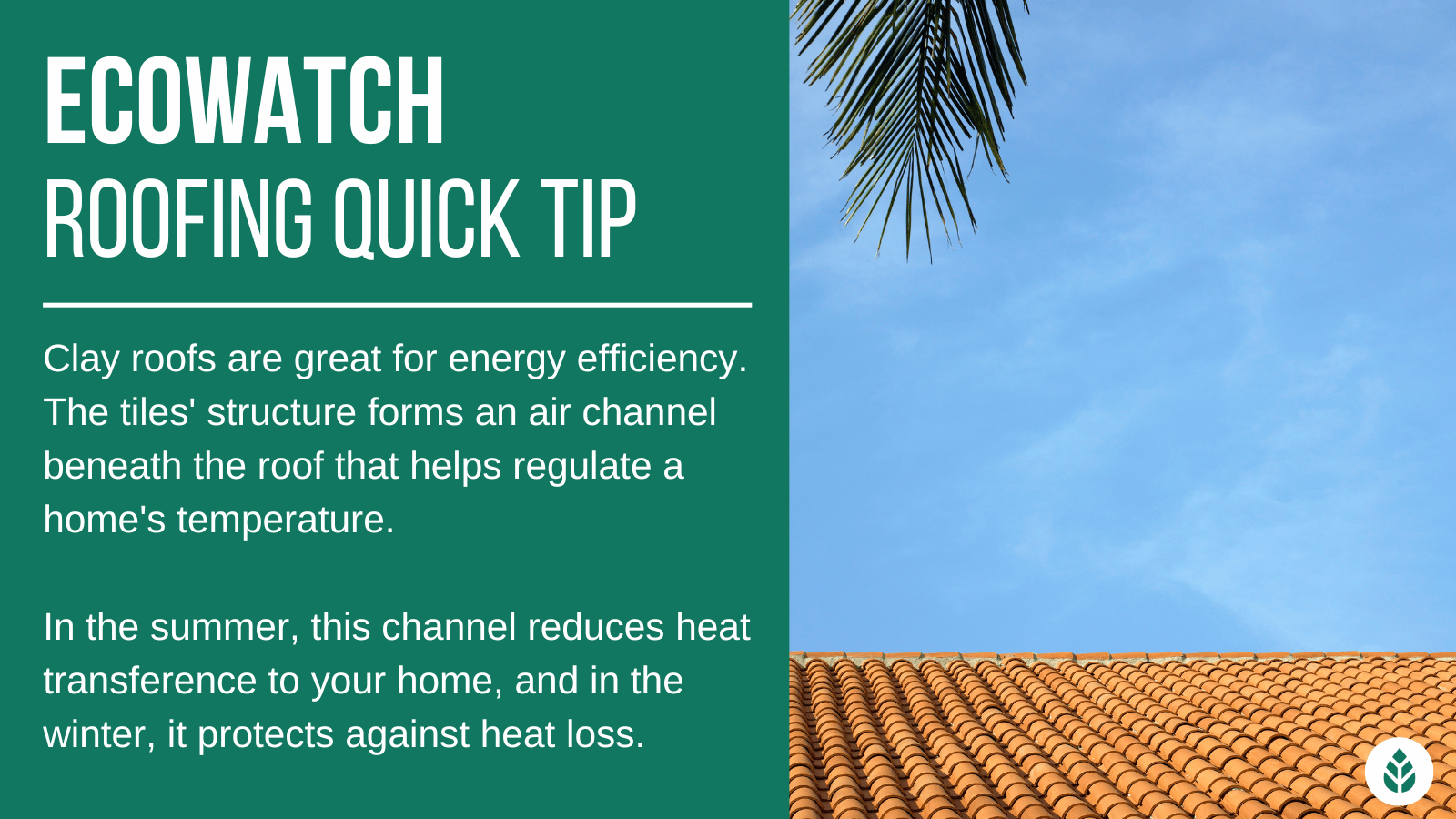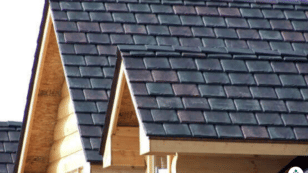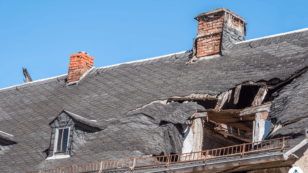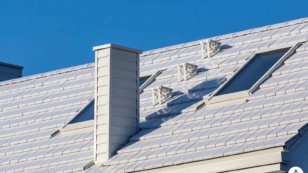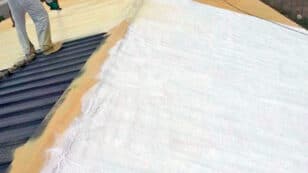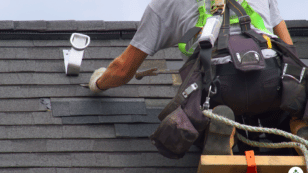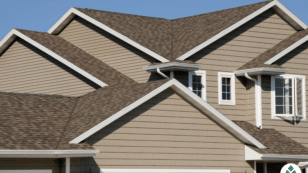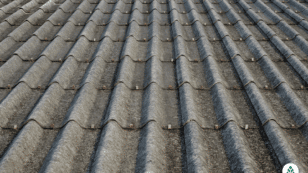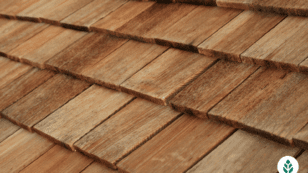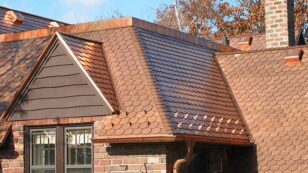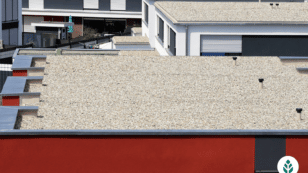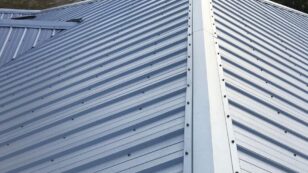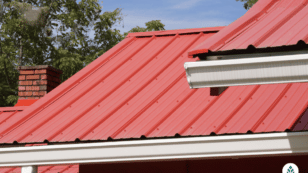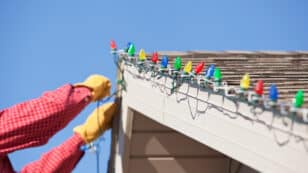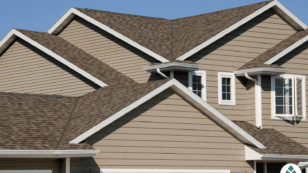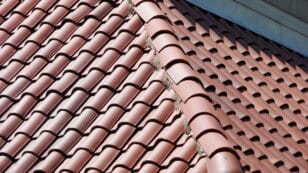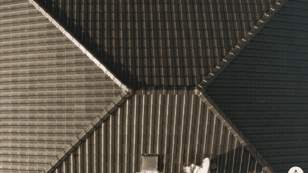
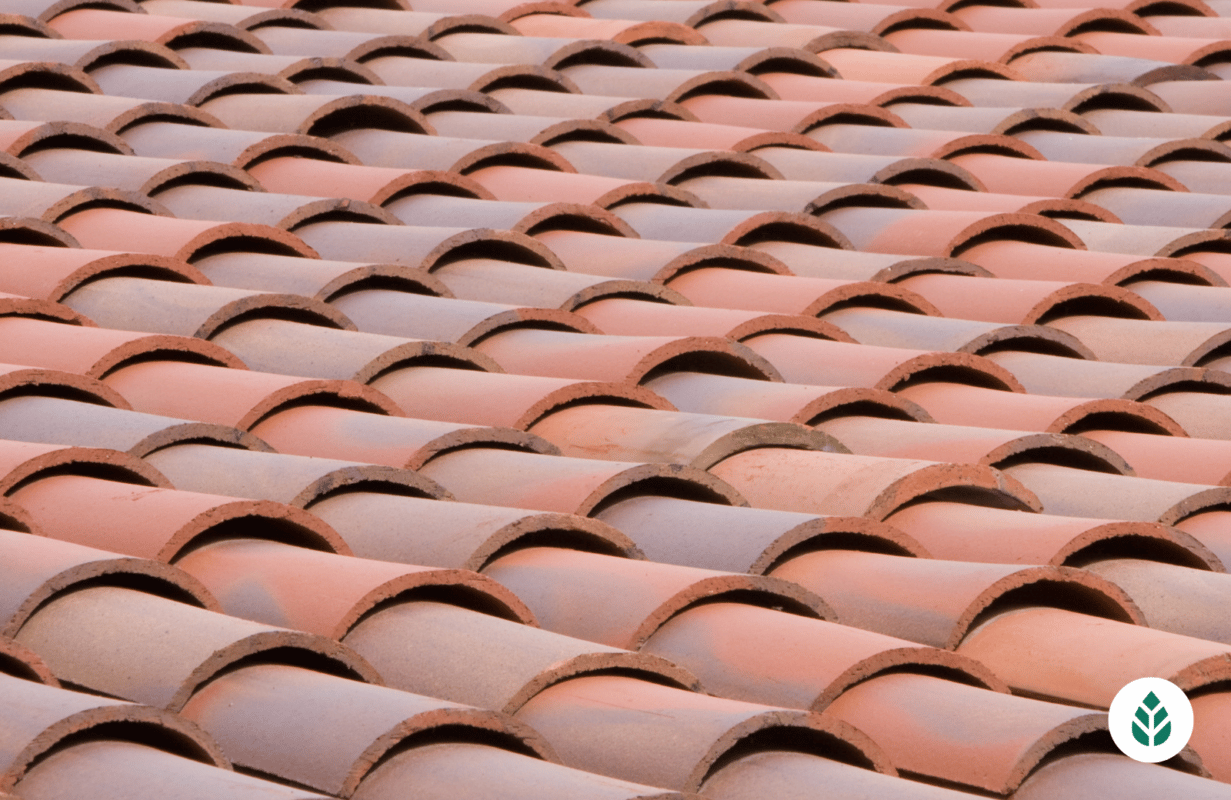
Clay Tile Roof Cost (Homeowners Guide 2024)
Average Clay Roof Cost: $30,000 – $51,000
- Clay tiles are durable and able to withstand harsh weather conditions
- Clay tile roofs have natural thermal resistance and cooling properties to improve the energy efficiency of your home
- Clay tile roofs cost between $6 and $20 per square foot
Each product and or company featured here has been independently selected by the writer. You can learn more about our review methodology here. If you make a purchase using the links included, we may earn commission.
A clay tile roof gives a classic Mediterranean or Spanish-style look to homes, adding texture and elegance that’s sure to boost curb appeal. Not only that, clay tile roofs have a long lifespan so you’ll save on roof replacement costs — as well as on heating and cooling costs thanks to clay’s natural thermal and cooling properties.
Installation costs for a clay tile roof range from $30,000 to $51,000 for the average 1,700-square-foot roof — depending on the type of tile you install. The average price of terracotta clay tile is between $6 and $15 per square foot, while the price of fired ceramic clay ranges between $8 and $20 per square foot.
Your total roofing cost will depend on the size and configuration of your roof, as well as on where you live, the roofing contractor you hire, and other factors we’ll discuss in this clay roof cost guide.
Cost of Installing a Clay Tile Roof
The price range for a clay roof is between $30,000 and $51,000 for the average U.S. roof size of 1,700 square feet.
Clay tile roof costs will vary depending on the type of tile you choose, with terracotta clay ranging from $6 to $15 per square foot and fired ceramic clay ranging from $8 to $20 per square foot.
While this is much more expensive compared to the cost of an asphalt shingle roof ($8,000 to $10,000), consider that clay roofs have a much longer lifespan. You’ll need to replace an asphalt roof within 15 to 30 years, while a clay roof will last 100 or more years.
How to Calculate the Cost of Your New Clay Roof
The only way to know exactly how much your new roof will cost is to get a quote from a professional roofing company, which you can do for free. But if you’d like to get a rough idea of cost, read on to learn how to estimate the price of your new roof installation.
The table below shows the average cost of material based on the type of roof tile.
| Roofing Material | Material Price per Square Foot | Material Cost per Square (100 sq. ft.) |
Estimated Cost for 1,700 Square Foot Roof Installation | Estimated Lifespan |
| Cement tile | $4 to $10 | $400 to $1,000 | $17,000 to $34,000 | 50 years |
| Terracotta clay | $6 to $15 | $600 to $1,500 | $30,000 to $45,000 | 100 years |
| Fired ceramic clay | $8 to $20 | $800 to $2,000 | $34,000 to $51,000 | 100 years |
If you know which type of tile you’d like to install, start by multiplying the material cost per square foot by your roof’s total square footage to get a price estimate for your new shingles.
Roofing material cost estimate = roof size x material cost per square foot
While this tells you how much you’ll pay for roofing material, remember that it only includes the tiles themselves. You’ll likely pay more for additional needed materials (like roofing underlayment), as well as your roofers’ hourly rate for installation. Those costs have been calculated into our table for a 1,700-square-foot roof, but will be different depending on the size of your roof and your location.
The only way to truly know how much your clay tile roof installation will cost is to get a professional estimate. If you’d like a free, non-committal roofing quote from one of the top roofing companies near you, click here.

Power Home

Average cost
Pros
- Positive industry reputation
- Lifetime or lengthy warranty
- 10+ years of experience
- Positive customer reviews
- Uses eco-friendly materials
- Well-trained, certified installers
- Variety of roofing styles available
Cons
- Limited variety of roofing materials
- Short or nonexistent warranty
- No financing information available
- Expensive
- Little information available on company website

Erie Home

Zero Down - 18 months same as cash with minimum monthly payment
Average cost
Pros
- Lifetime or lengthy warranty
- Widespread availability
- 10+ years of experience
- Positive customer reviews
- Uses eco-friendly materials
- Financing options available
- Well-trained, certified installers
- Uses durable materials meant to last
- Variety of roofing styles available
Cons
- Limited variety of roofing materials
- Expensive

Aspen Contracting

Average cost
Pros
- Positive industry reputation
- Lifetime or lengthy warranty
- Widespread availability
- 10+ years of experience
- Positive customer reviews
- Financing options available
Cons
- Little information available on company website
Still, a clay roof is expensive, so here’s an insider tip: You can opt for cement or concrete tiles that mimic the look of terracotta tiles at a more affordable price range of $4 to $10 per square foot (total cost around $17,000 to $34,000 for a 1,700-square-foot roof). Concrete tile roofs still have a pretty long 50-year lifespan — however that’s half the life expectancy of clay tile roofs.
Keep in mind that tile roof installation costs will vary depending on the size, layout and pitch of your roof, as well as local installation costs in your area. Here are some other differences between clay and tile roofs to consider:
Clay Tile Roof Price Factors
The total cost of your clay tile installation will depend on a variety of factors, including the type and brand of tile you choose, labor costs where you live, and which roofing company you choose to hire.
Let’s explore some of the most common cost factors for clay roofs.
Material Pricing for Clay Tiles
Your roof options don’t stop with choosing a base material such as terracotta clay or fired clay ceramic tiles. There are many different styles of clay tile roofs, including Spanish tiles, Double Roman tiles, French tiles, flat tiles and more.
The average costs for clay roofs range from $6 to $20 based on tile material and style.
Basic Labor Cost and Time to Complete Clay Roof Installation
Roofers typically charge a flat hourly rate that will vary by location, but you may see additional fees if your roofing project is more risky or complicated. In general, labor costs for clay tile roofs are higher compared to other roofing materials because clay tiles are heavier and more complicated to install.
Clay roofing materials also take longer to install, with an average timeframe for a clay tile roof being between three and five days, depending on complexity of your roof and weather conditions. Comparatively, an asphalt shingle roof takes between one to three days to install.
Removing Your Current Roof and Dump Fees
If you’re replacing an old roof, you’ll be charged a fee for removing your old shingles and disposing of them. If you’re replacing a shingle roof, your removal cost is roughly $0.30 to $0.70 per square foot, and to remove a tile roof it’s roughly $0.75 to $1 per square foot.
Roof removal may or may not include material disposal, so be sure to ask your roofing company about that up front. Asphalt shingle recycling may or may not be available where you live, but clay roof tiles can be easily recycled.
Size and Complexity of Your Roof
As we mentioned, the complexity of your roof can increase roof installation costs. If you have a tiered roof or a lot of dormers, you may have to pay more. Other complicating factors include chimneys, skylight windows or HVAC systems.
Unsurprisingly, the price for roof installation will also factor in the size of your roof.
Pros and Cons of Installing Clay Roofs
As with any roofing material, there are pros and cons to installing a clay tile roof. Here’s a quick look:
| Pros of Clay Roofs | Cons of Clay Roofs |
|
|
Lifetime and Durability of Clay Roofs
One of the biggest benefits of installing a clay tile roof is its unmatched lifespan, expected to be at least 100 years. While clay tile is relatively low maintenance, there are some things you can do to ensure that it stands the test of time, like having your roof professionally cleaned, inspecting it annually and sealing your tiles.
Clay roofs hold up well against strong winds, heavy rain and hail storms. While they are fire resistant, they’re not fireproof. The biggest threat to a clay tile roof is heavy falling debris like tree limbs, as the tiles can crack with a strong enough impact.
Clay tile roofs are a popular choice in warmer climates because of their natural cooling ability, but they’re a good choice for cold climates as well because clay is a great insulating material.
Are Clay Roofs Environmentally Friendly?
Yes, clay roofs are a great choice for the eco-conscious homeowner and have natural energy efficiency capabilities that can save you money on heating and cooling costs.
First off, clay comes from the earth, so clay roof tiles aren’t made out of any synthetic materials or components that could be harmful to the environment. When clay tiles are removed from your roof, they are fully recyclable.
As mentioned, clay is a dense material and an incredible insulator. While clay roofs aren’t as energy efficient as metal roofs that fully reflect the sun, clay does emit heat instead of absorbing it. Clay tile roofs are also typically lighter in color, which will help to keep your home cooler.
The overlapping manner in which clay tile roofs are installed also help to keep your home energy efficient, as it allows for natural ventilation and a thermal barrier between the tiles and your roof deck.
Financing Your New Clay Roof
We believe a clay roof is a worthwhile investment, but it’s a hefty expense not many homeowners can afford to pay up front. Fortunately, there are financing options available to help you pay for your new roof, as described below.
- Pay cash: If you can afford it, paying with cash up front is the best way to save on your roofing installation without any interest charges.
- Bank loan: Your local bank may offer personal or home improvement loans to help pay for your new roof.
- Loan through your roofing provider: Many roofing companies have in-house or third-party lenders you can borrow money from. Just be sure to get a loan with the lowest interest rate possible.
- Home equity line of credit (HELOC): A HELOC is a revolving type of secured loan that uses your home as collateral. You can use a HELOC to finance home improvement projects like a new roof.
- Shop around: We recommend getting at least two to three quotes from different roofers to make sure you’re getting the best deal possible. If you’re ready to start shopping, click here to receive no-obligation roofing quotes.
The ROI of Your Clay Roof
New roofs have been proven to increase home value, but with its elegant look and 100-plus-year lifespan, a clay tile roof can add tremendous value to your home.
In one analysis of return on investment for home improvements, asphalt roof replacement raised home value by nearly $18,800, leading to an ROI of almost 60%, while a metal roof replacement increased home value by $28,000, giving homeowners an ROI of 55%.1
While the analysis didn’t include clay tile roofs, we anticipate that homeowners who invest in this roofing style would see a home value boost of well over $28,000, considering that they last 50 to 60 years longer than metal roofs.
Costs of Maintenance and Repairs for Clay Tile Roofs
One of the biggest benefits of a clay roof is its long lifespan, but you’ll want to keep it well-maintained to ensure its longevity.
Aside from fixing broken or chipped tiles, the most common repairs and maintenance associated with clay tile roofs are repairing leaks and reinforcing the roof structure to support the heavy weight of the clay material.
The average roof repair cost for clay tile roofs is between $350 and $450, with an estimated $4 to $20 per square foot.
You should have your roof inspected annually, especially during your warranty period. That way, if you have any broken tiles that need repair or replacement, it’ll likely be covered under your roofing warranty.
Roof Painting Prices for Clay Tile Roofs
Clay tile roofs come in a variety of colors, but should you want to change or refresh your roof back to its original glory, the costs of painting it can range between $4 and $10 per square foot.
While roof painting may seem like an easy DIY project, we recommend choosing a trusted roofing contractor for the job. However, if you do choose to paint your own roof, be sure to clean it thoroughly beforehand and select a good primer to protect your tiles and keep the paint intact.
It’s recommended to use acrylic paint for clay roof tiles. However, you should never paint terracotta tile roofs, because paint will not adhere to the glazing.
Costs of Cleaning Your Clay Tile Roof
Another benefit of a clay roof is that roof rot and mildew aren’t as big of a concern compared to roofs made of asphalt or wood shake shingles. Still, as your roof ages, moss, algae and mildew growth is possible, especially if you live in an area with a lot of rainfall.
Professional roof cleaning prices vary by method, but clay tile roofs can only be safely cleaned with low-pressure power washing, a chemical wash, a soft wash or manual moss removal.
The average costs for cleaning a 1,700-square-foot clay tile roof with these methods are as follows:
- Low-pressure power washing: $0.30 to $0.70 per square foot, or an average of around $930
- Chemical wash: $0.15 to $0.30 per square foot, or an average of around $340
- Soft wash: $0.30 to $0.80 per square foot, or an average of around $650
- Manual moss removal: This is the most expensive type of cleaning, costing between $0.60 and $1.00 per square foot, or an average of around $1,200
When you’re choosing a cleaning method for your roof, we suggest thinking about the eco-friendliness of each option before moving forward. Manual moss removal will usually cost more than loading up your roof with chemicals, but you’ll also have a much less negative impact on the environment.
Because clay roofs will send a lot of rainfall and debris sliding right off your roof, you may want to invest in gutter guards to keep your gutters from getting clogged.
Are Clay Tile Roofs Worth the Cost?
The answer truly depends on what’s most important to you and the climate you live in. If you’re looking for a stylish, long lasting and durable roof, a clay roof is certainly worth the cost.
Also keep in mind that clay is a bit easier to maintain and likely won’t need to be replaced or repaired as often as other roofing materials — and will help regulate the temperature in your house. Therefore, your clay roof is an investment that will lead to lower costs over time.
If your top priority for a roof is affordability, you may want to consider asphalt or wood shingles or look into metal roofing options.
FAQ: Clay Roof
Clay roofs are extremely durable, can last 100 or more years and are one of the most energy-efficient options, making them a worthwhile investment.
Yes, you can install solar panels on tile roofs. In fact, it’s an ideal choice because tile roofs are sturdy and long lasting, meaning you won’t need to replace your roof to install solar panels. However, keep in mind that if clay roofs aren’t popular in your area, local solar panel installers may not know how to install them on that type of roof.
A clay roof can last 100 or more years if well maintained, making it the longest-lasting roofing material.

 233k
233k  41k
41k  Subscribe
Subscribe 
